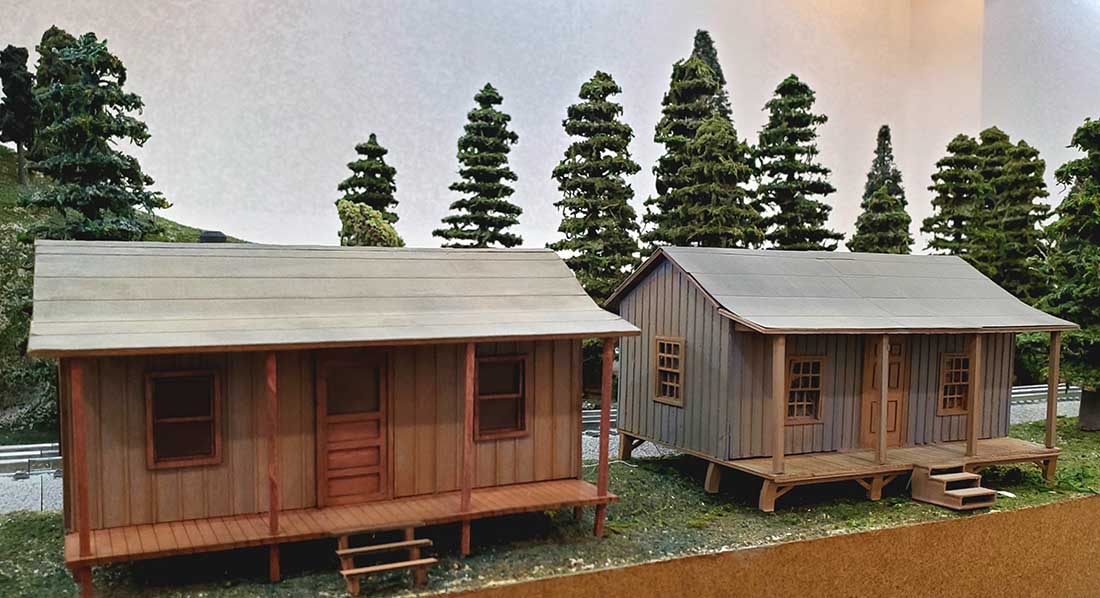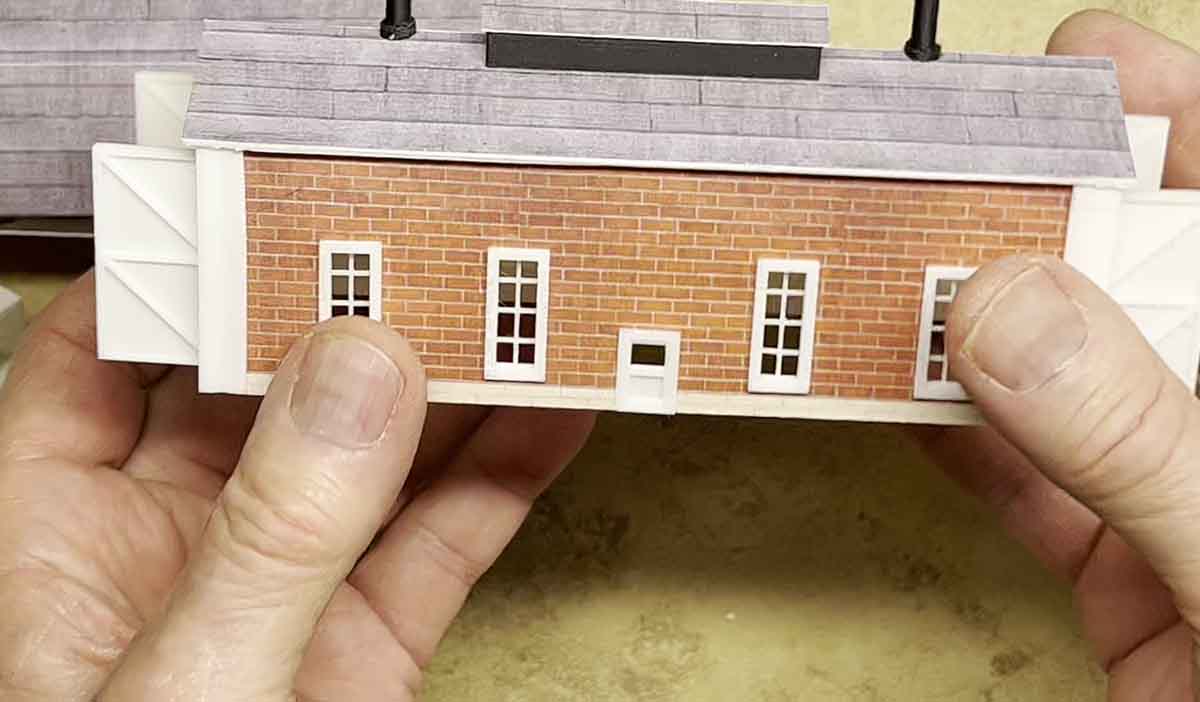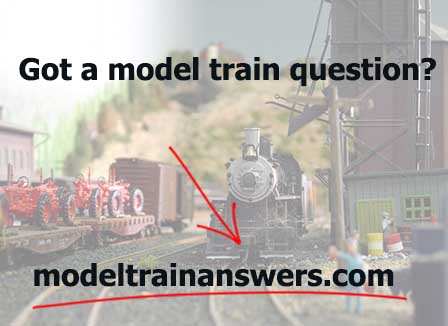George has been back in touch with some good model train 3D print advice.
(If you missed his last post, it’s here: 3D printer model railroad.
A Primer of 3D printing – I learned all about 3D printing from our local library. They have a Maker’s Lab there with wonderful people who teach TinkerCad & then 3D print for you @ $1.00 per hour.
Tinkercad (TC) is a program meant to teach young kids how to create things graphically then use a computer file to send to a 3D printer and the printer makes what the person drew with TC.
TC is rudimentary and yet does some powerful Cad things so if you wanted to make an I-phone holder you draw it up, export it to an .STL file and send that file to another program called a slicer, something that the printer requires & interprets, and the 3D printer goes to work making that item.
A 3 step process – draw or download something, slice it, print it.
A 3D printer works by adding molten plastic layer by layer exactly where that slicer program tells it to. An analogy is if you had a tube of toothpaste, with an infinite supply of paste, and you made a circle of paste on the table and exactly made the next layer on top of the other you’d have a circular wall made of paste X layers high. That’s how a 3D printer works only with a paste size of .07 mm and an exact plan location so it can make any shape nicely & smoothly of a material that cools quickly into a hard and strong substance.
There are two types of printers- filament & resin. The filament type takes a spool of plastic line – looks exactly like a hedge trimmer line-melts it, and forces it thru a nozzle unto a plate and builds the work layer by layer.
The resin type has a reservoir of liquid resin that is forced thru a nozzle and similarly builds the work. The resin type requires handling noxious chemicals but can perform more precise work. We will only concentrate on the filament type.
You don’t have to draw in CAD in order to 3D print something. There are a gazzilion items on the net that you can download. Selected items should be in either .stl or .obj format.
If the size and aspects are just right then send it to a slicer program which the printer needs in order to print. The slicer program can be free and if your Library 3D prints you don’t need a 3D printer.
The problem with this is the only mod you can make is to increase or decrease the size by % in the slicer program but that may be all you need. I use Prusa as a slicer program but there are
others.
TC may be useful to some who want to create some things or do some minor mods to .stl files.
If you require precise dimensions best go elsewhere because this simple program will frustrate you. I have created things in S ( 1/64 ) scale that I couldn’t find anywhere and used TC for simple stuff.
An .stl file is similar to a pdf made from a CAD file. It shows all the aspects of the original but you cant manipulate it like you can with CAD. So if you downloaded an .stl file of a wooden pallet from the net, put it in TC, you may modify the outer dimensions, crop a piece of it, add something to it, but you cant change the parts of the item. In many cases this is all you need.
SLICER PROGRAMS
Once you get into these programs you’ll realize what a printer needs in order to produce what you want in quality and speed for your model train prints. It is here that some assistance from an experienced person is helpful. I had my Library folks help out because this process does need tweaking until all is right with settings.
The first premise is that a nozzle must feed filament unto something. If you take the toothpaste analogy and want to extend the wall outward somewhat higher up there is nothing but air below and that paste layer will just fall to the table. The slicer program will put a support where a layer wants to go and thus no air will be under a nozzle. Supports, adhesion, thicknesses, and numerous instruction sets are in the slicer program and it doesn’t take long to learn what has to be done. So an .stl file goes into the slicer cruncher and out comes a gcode file that the printer
needs to function. That’s the process.
PRINTERS
There many brands and this lesson is for filament type only. With some assembly the printer should be placed on a stable platform. Filament should freely come off the spool, area should be free of dust and moisture, lighting adequate, and if noise is an issue then that should be addressed.
I find that the build plate requires the most attention, extreme care in work removal that is stuck to the plate is required by using non metallic scrapers, and 90% alcohol used to keep the plate
spotless. Once the setup is done only occasional light oiling and keeping the printer clean is all that is needed. The first layer adjustments per the manufacturers instructions is all that is required at first.
Occasionally there will be a nozzle clog, or sometimes poor design of the work, some glitch in the gcode, or an adjustment in the slicer program that creates a crash but the printer in these cases is not at fault. There may be some reconfigurations of the work required and its nice to have some buddies to compare notes.
Just because it all looks good in CAD doesn’t mean it will print well. These are causes for most failures or disappointments in printing.
Only buy from an outfit that will respond to your inquiries and has a good support record with parts & manuals. Chineziem is out.
Model train 3D print:
FILAMENT
I wont go into all the aspects of the varied filament types available here- the net is full of info and the specs. The PLA type is what I use for modeling. One important factor is PLA absorbs moisture and when it does it may not print well so drying it out may be necessary. PLA will melt in a hot car and there are stronger filaments available. Various colors are available and a decent manufacturer is recommended- cheap here is not the best way. Some colors of the same brand may print differently and the special types such as wood based or shiny may require a totally different setting in the slicer program.
CONCLUSION
I have had a grand time playing with TC, designing stuff, planning things that others don’t have, I love S scale and American Flyer and there so few things in that scale so I now can make them. I
firmly believe that without counting my time I‘ve made things cheaper than purchasing, and this has expanded my Hobby. Now I think differently and with a full metal shop, I may 3D it instead.
Making people in S scale is a bear. Resin printing is much better than filament for figures.
You’ll never get facial detail in filament but I will not invest in a resin process because of the ventilation and environment required so people detail will suffer. May have to buy some stuff.
My criteria for 3D CAD is it must be free-forever. I hate cloud based stuff, so I’ve limited my choices and at my age learning new CAD is brutal. I am well versed in a plan called Nano-cad but the 3D is too expensive. FreeCad is torturous- I just cant grasp it.
All serious modelers should think seriously about 3D printing.
George”
A huge big thank you to George for putting this model train 3d print overview together – I thought it would be fitting to show some of the 3D posts too:
That’s all for today folks. A big thanks to George for his model train 3D print advice.
Please do keep ’em coming.
And if today is the day you get started on your layout, the Beginner’s Guide is here.
Best
Al
PS Latest ebay cheat sheet is here.
PPS More HO scale train layouts here if that’s your thing.






Thank you George…a very clear and well-written introduction to the subject. There is a lot to learn – especially if one is not “into” computers – but as with many things one needs to put in a bit of effort to reap the benefits!
Amazing what’s being done. Thanks for a very informative article. 3D printing a boon to our hobby!
Excellent primer on 3D printing. Thanks so much for taking the time to write this.
A big thank you to Prof. George: Thanks for this well written tutorial on 3 Design and Printing. This is a new form of fabricating custom items for your train layout in any size. Really neat!
John-LINY
Great explanation and I really appreciate the help and advice. Very timely information and well written and explained.
Thx again!
Dan
Does the finished product come out in color, or do you have to paint it to completion? I.E, photo #2 of the brick building.
Thanks for this useful information from end user. George.
George a magnificent and very instructive explanation of 3D printing. Great samples. I consider myself a computer person but thus would be quite extension to my skills.
George, great write up..When my interest in 3D printing surfaced, I tried many different apps.I settled on Autodesk 3D cad software as they have a license free for hobbyist. I haven’t found any limitations as for our modeling applications. There are an endless amount of training tutorials covering simple to complex.
looks like opening day of trout season. nice work.
Thank you, George, for your reply to my questions. However, I was really asking if you could supply me with your STL files for my printer. I have been printing with my 3D printer for some time now, but I cannot find the files I want for my HO train layout. And when I saw your pipe and valve 3D print, I really wanted it.